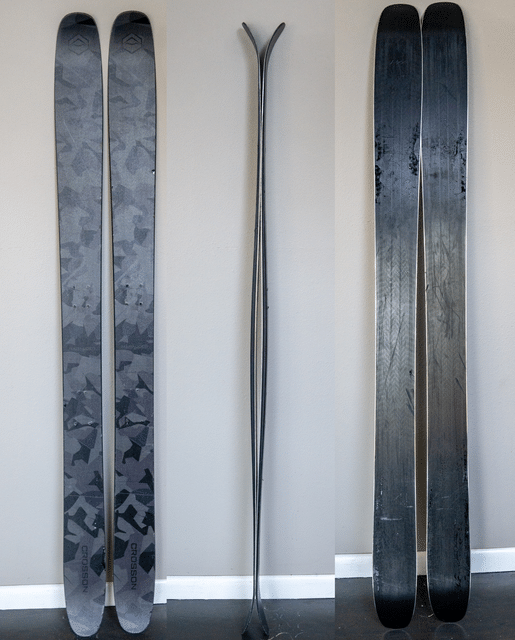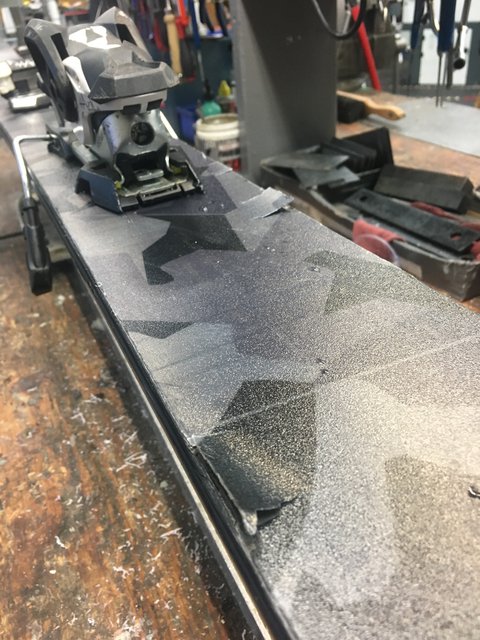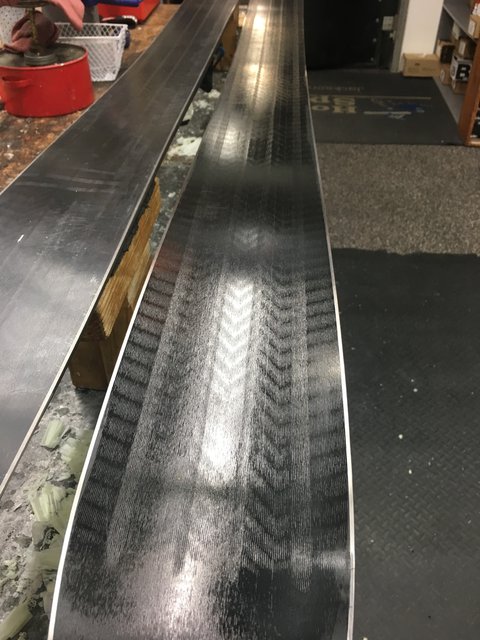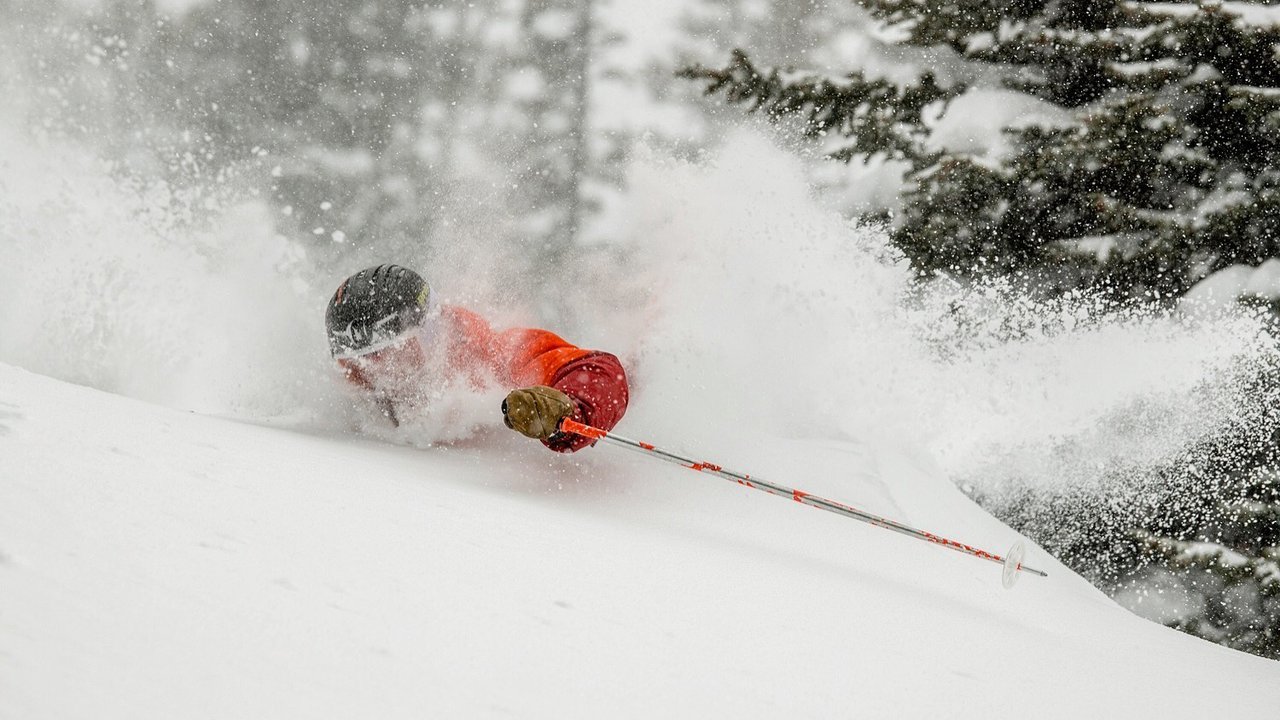Ski: Crosson Maurader
Length skied: 186cm
Actual Length (Tip-tail w/ straight tape): 186
Measured weight (each ski): 2132g ea.
Shape: 139.51-115.81-131.21
Sidecut: 26 meters
Mount: -3.75 from center
Binding: Tyrolia Attack 16
Days skied: 20+
Reviewer height/weight: 5’8” 170 // 5’5” 140
Review Location(s): Jackson Hole Mountain Resort
Conditions skied: Variable Snow, Powder, Groomed Trails, Moguls
Reviewer Intro: I [Erica], and my boyfriend, Dylan, are based in Jackson, Wyoming and are taking on Newschoolers’ Powder Ski Roofbox Reviews this season. We’re lucky to be able to ride the same skis and look forward to bringing multiple perspectives on the top powder skis out there right now.
You may have heard of Crosson Skis after they brought on athletes like Bobby Brown and Banks Gilberti onto their team this past year. Handmade in Seattle, WA, Crosson Skis are derived from their strong roots in aerospace manufacturing and have brought these principles to their factory to craft skis that are unique to this industry.
We had the opportunity to hop on the Marauder, an aggressive powder ski coming in at just under 116mm underfoot. Upon first receiving the skis and contrary to the manufacturer’s description we noticed mild tip and tail rocker and quite a bit of camber underfoot. They definitely looked like they would charge and we’re looking forward to seeing how they perform in deeper snow.
At 2132g per ski, they felt light given their size, but overall are pretty comparable to many other similar skis we’ve been on this winter: Moment Commander 118 (1932g), ON3P Jeffrey 116 (2340g), Lib Tech UFO 115 (1866g).

Crosson offers its skis with a variety of base patterns, including some interesting 3D ones as they call it. We opted to go with what they recommend for the Marauder which is the Pow 3D base pattern. We didn’t know what to expect of this finish but upon arrival, we were surprised. The base appeared to have what I would best describe as chevrons running both directions, as well as 3 very deep grooves in the base. I typically choose a much finer base pattern when tuning skis as the local shop so that my skis will break free and go sideways easier, as deeper base patterns tend to not be as playful, but we kept the stock pattern for the duration of the test.
Shape / Flex / Construction:
Crosson describes the Marauder as “An ideal combination of aggressive tip and tail rocker and mild camber underfoot makes it easy to keep the tips up, while still maintaining control on the groomers. Due to its carbon fiber construction, the Marauder is extremely light for its width, making it far more nimble than most powder skis on the market today” which had both of us pretty excited to try the ski out, it seemed like a perfect combination for the mix of inbounds and backcountry access we have here in Jackson.
However, upon receiving the skis I would describe them more like this; the Crosson Marauder features a significant amount of tip and tail taper combined with a rocker profile that I would call minimal tip and tail rocker with a lot of camber. Not only is there more camber in this ski than any ski I have skied for a long time, but this cambered section is extremely stiff requiring both hands clamping the center of the ski together to de-camber it. Once de-cambered the rocker profile changed drastically and actually produces something more similar to the deep rocker lines in the manufacturer's description.
The ski features a standard sidewall construction with decently thick edges, no specs were given by the manufacturer but they don’t seem abnormally thick or thin. The flex profile of this ski is stiff overall with a very stiff midsection. When mounting the skis there was a very thick layer of black material before hitting the wood core. Based on Crosson’s description of the ski and listening to the podcast on Blister with the owner of Crosson, it can be assumed to be a thick layer of carbon and rubber. This material provides a large amount of grip on the screws and actually makes them very hard to put in, luckily this means they should also be very hard to pull out so binding retention shouldn’t be an issue on this ski. There is no metal in this ski and it seems that the rest of the core is wood so the component materials of this ski are pretty simple with no marketing gimmick materials.
On-Snow Performance
Groomed trails:
E: With all the camber in the skis, they do pretty well on-piste. They have a really chargey feel to them and carve well on the groomers. Not necessarily total tip to tail smooth edge deep carves, which I’ve achieved better with skis like the Commander and Wrenegade but they rip nonetheless given their status as a pow ski.
D: This ski needs a fair amount of speed to come to life on groomers, most likely due to the long turn radius and the stiffness. Once at speed the camber provides a good edge hold and the tips don’t flap at all. I found them a bit challenging to engage into smooth arcs at first , they need a bit of concentration to achieve a good carve but after a few days on them it became as intuitive as any ski that I’ve spent a decent amount of time on. These skis definitely inspire confidence at speed.
Powder/Float:
E: The Mauraders blasted through pretty much everything, and are a fun option with fresh snow, but I would lean for them more on a 6-10” day, rather than a 10+”. As aforementioned tip rocker is pretty mellow, which I think impacts the float. I didn’t experience them diving under more than once or twice, but they’re also not in that spoon-tipped floaty category like the Lib Tech UFO 115s either. In both powder and mixed conditions, the skis tended to shoot out/in on me (e.g. I’d be skiing along and one of the skis separates from my center of gravity). I know both Dylan and I experienced this, and it would probably be my biggest complaint about the ski.
https://www.newschoolers.com/videos/watch/939678/Crosson-Pow-mp4Erica finding pow with the Mauraders
D: In pure powder this ski was underwhelming for a ski of its width. I found the tips to dive pretty aggressively when skied with any kind of forward stance, it seemed to me like the very strong camber would push the tips further and further into the snow while the stiff tips and minimal rocker didn’t fight back against this to let the tips rise. I suffered from multiple stuffed tips as well as punch fronts on landings. Part of this issue is probably also from the fairly centered mount point, which provides some of its own advantages but doesn’t help with floatation. That said it obviously floats better than a ski around 100mm underfoot but I wouldn’t say it performs much better in pure pow than a ski of say 108mm. During denser snow days the float proved to be adequate enough, so the lack of float may be due in part to the fact that these were designed in Seattle which sees a fair bit of denser snow than Jackson does.
Mixed conditions:
E: Given its heavy camber, mixed conditions or an inbounds powder day is where these skis really shine. I had a couple of powder days completely inbounds with them and as even when the snow begins to get chopped up, the Marauders continue to perform well. Again, there’s the issue with the skis spewing out, which likely is due to the taper of the ski getting caught in variable snow and deflecting around obstacles rather than through or over them.
D: I found that chopped snow was where this ski excelled, especially if the chop was on the denser side of the spectrum. The stiffness combined with the rocker profile provided a stable platform to blast through pretty much whatever you want. I did find, as Erica mentioned that at certain points one of the skis would deflect to the side seemingly without warning. This seemed to be caused by the aggressive tip taper hitting a firmer piece of snow and deflecting around it instead of over it. This issue can be quite annoying on some days when there is refrozen crud under the pow that you are trying to ski. However, the ski provides an incredibly stable and smooth ride in the right conditions it inspires confidence to go fast and straight line things.
https://www.instagram.com/p/Bs9TKjvlwbb/
Playfulness:
This ski is moderately playful, it feels comfortable in the air and stomping landings as well as going fast. The stiff flex isn’t the most playful for doing butters or tail pressing but the close to symmetric sidecut and centered mounting point makes the ski easy to pivot and slash as well as being easy to spin and flip off airs.
Durability:
Within the first couple of days, we experienced a lot of top sheet chipping (see: 4 chips in the first 2 ski days). We reached out to Crosson about this:
“The pair you have is an older R&D pair which we were aware of the issue previously. We’ve altered our topsheet laminate schedule and addressed the issue on all of our production skis. Our athletes have tested them and the issue no longer persists.”

Overall, the base has hit a few rocks, but there isn’t any significant damage to the bases or sidewall with ~15 days of riding. After epoxying the topsheet chipping, we didn’t have any more issues with it.
Base Pattern:
As discussed earlier the base pattern is one of the more interesting parts of this ski. In the podcast with Blister and the owner of Crosson he goes into why they make these patterns and he is very proud of the ones they have created. Despite my initial reservations about the pattern I didn’t find anything particularly negative about it, it fact it proved to be very fast in all conditions both forward and backward and the ski was plenty maneuverable. However, I do believe if you were to put this pattern on a ski with a more rearward mounting point and less symmetrical sidecut you may end up with a very demanding ski.
My one complaint about this pattern is that if you were to damage the base enough to require a tune, or just wanted to get a base grind you would end up with whatever pattern is set in the tuning machine, but still have those 4 deep channels that the stone wouldn’t touch and who knows how those channels would react paired with a different pattern. To remedy this and put a standard base pattern in you would have to grind off a significant amount of the base of the ski which would drastically decrease the skis life, which a shop tech that wasn’t paying attention may just decide to do to get a good finish on the base without realizing that the grooves were meant to be there. So if you were to get the 3D pow base structure I would say be willing to have Crosson do your tuning, or let the shop know that the grooves are there and not to try to grind them out. Crosson does offer 2 years of free tunes for the owner, however, unless you live in Seattle this would be hard to take advantage of.

Conclusion:
The perfect person for this ski hard to pinpoint. It seems to me that the shape of the ski conflicts with the rocker profile and flex, it seems to have a playful shape, but minimal rocker combined with the sturdy flex makes for an in-between ski. The Maurader makes a good resort in-bounds pow day ski where you are only skiing fresh pow for a couple of runs and then skiing the crud that develops as the mountain gets skied.
I would put it in a category with skis like the Moment Commander and ON3P Wrenegade where you know the ski shines in choppy snow but it’s likely not always your first option on a chest-deep day. If chopped up resort snow is what you end up skiing on pow days this could be a great ski for you, especially if you like to throw the occasional trick when you find the right air. This ski is not for someone looking to ski untracked pow at all times, or someone looking to ski like the nimbus crew.


Comments